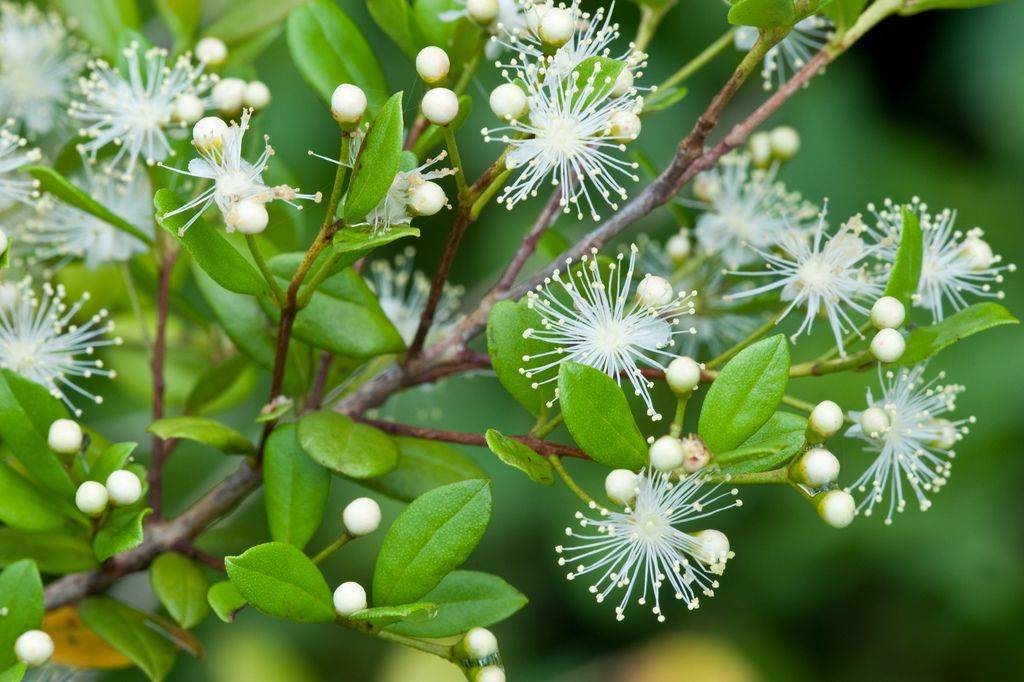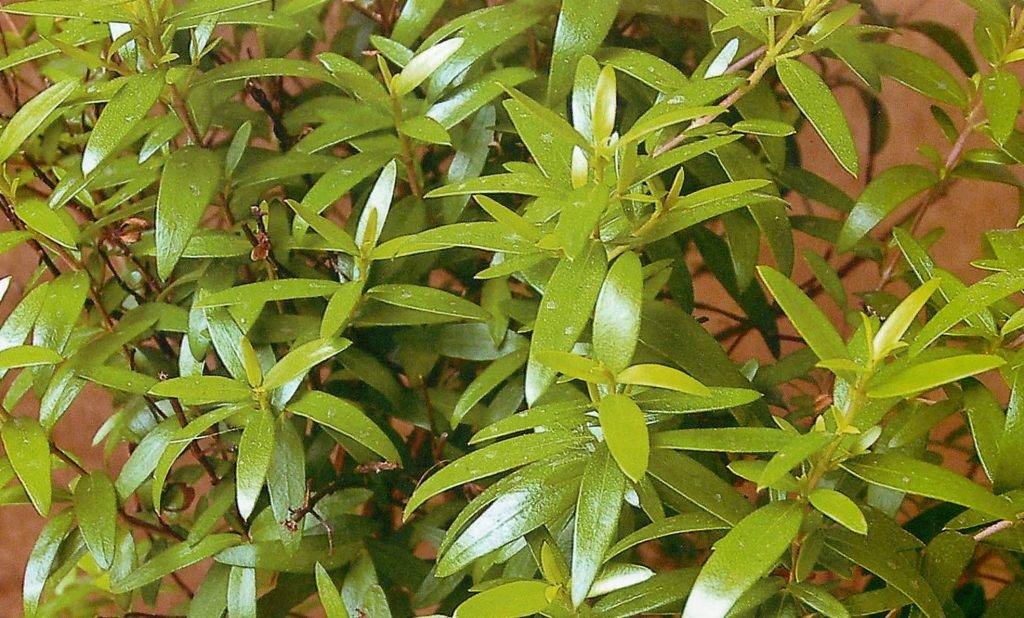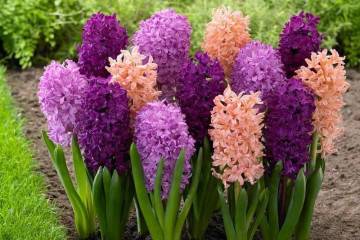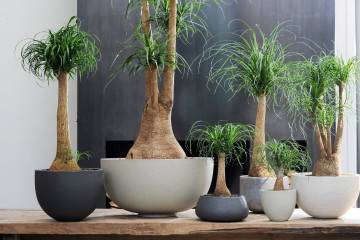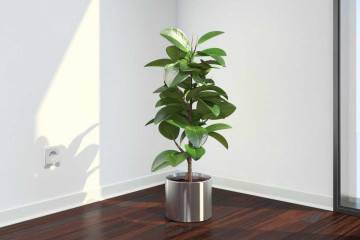Indoor plant myrtle - home care
Content:
Myrtle, or myrtle tree, is an evergreen tree-like plant belonging to the genus Myrtle, or Myrtus. It is loved by many flower growers for its spectacular appearance, symbolism and a long history, which includes many beliefs and interesting legends. To grow a beautiful tree at home, you need to know about its structure and how to properly care for myrtle.
Appearance and family
The plant belongs to the genus of shrubs and trees of the evergreen type, widely distributed in Europe, Cyprus, the Caribbean and Florida. Its history dates back to ancient Greece, and the Mediterranean is the birthplace of myrtle. For many centuries, the tree has been considered a symbol of beauty and youth, family happiness and peace. The cultivation of myrtle as an ornamental flower has been going on for as long as 400 years.
This shrub has straight and fairly branched stems with dense and leathery dark green leaves. Each leaf has a slightly pointed elongated shape, the leaves themselves grow often and quickly, holding on to small petioles, their length is from 2 to 5 cm.They can be of different shapes, it depends on the type of plant, for example, the Hekven species has leaves with characteristic wrinkled edges. Also, the leaves have a characteristic luster and a pleasant aroma coming from glands with essential and aromatic substances.
Popular varieties
The myrtle tree has about a hundred different varieties, it can be found in different parts of the world, but the most common is the Ordinary Standard Myrtle or Communis. Also popular are large-leaved and small-leaved and lush myrtle, varieties Ralph, Hekven, Tarentina Granada and many others. They all differ in the shape of the foliage and branches, as well as the shade of the fruit.
Healing properties
From ancient Greek, the word "myrtle" is translated as "balm", which is no coincidence, because it has many useful properties and is highly valued by physicians. From myrtle small flowers, tinctures are made used for pathologies of the intestines, heart, kidneys and liver, cancerous tumors, diabetes, allergies and sinusitis. Essential oil from myrtle, which is used in cosmetology, is also useful. Myrtle flower perfectly cleans the indoor air and prevents the spread of viral and bacterial organisms indoors.
History of appearance
For the first time a tree called myrtle was mentioned in 1499 in the Gennadiy Bible, and the history of its appearance has several variants. According to one legend, this plant was brought to earth by Adam after his expulsion from paradise, according to other sources, Aphrodite wore a wreath of myrtle, so the tree began to be considered sacred. Another legend is associated with this goddess, according to which she swore eternal life to Adonis, therefore many magicians use myrtle in witchcraft rituals.
Features of home care
An indoor flower called myrtle requires special attention and good care. So that the tree begins to bloom.it will need to create optimal conditions, including temperature, humidity, light, soil and fertilizers.
Temperature
Myrtle is a capricious plant, for this reason, home care begins with the selection of the temperature. In winter, the tree will feel optimally at 10-12 degrees, in spring and early autumn the optimum temperature will be 20-22 degrees. If the plant is kept in hotter conditions, it will begin to shed its leaves, and it is also not placed next to the air conditioner.
Lighting
Myrtle vegetation depends on good lighting. He will be fine in a bright room, but you need to take into account that bright light is useful for the plant, but with shading. Due to the characteristics of the shrub, diffused lighting is not suitable for it, because of which it will begin to bloom worse.
Watering
The tree loves moisture very much, it is watered abundantly at least 4 times a week so that the substrate dries up 1 cm after each watering. In winter, the plant needs to be watered once every 10 days. For this purpose, use settled slightly warm water, having previously supplemented the near-stem circle with bark or a coconut substrate to preserve water in the soil.
Spraying
All varieties, including Communis myrtle and Marsh myrtle, are often sprayed because the plant cannot tolerate dry air. The plant should be placed on a pallet with moistened pebbles or next to an aquarium or humidifier.
Humidity
Myrtle is a houseplant and requires a high level of moisture in the soil and cannot survive without regular spraying. In order for the tree to grow and delight with a flowering view, it is watered and sprayed in a timely manner.
Priming
Knowing why the myrtle tree needs a quality substrate, you can grow it at home with little effort. The plant is suitable for a universal soil with a pH of 5.3-6.4 or a soil for citrus fruits. The mixture is also prepared independently, including when planting, mixing garden soil, humus and perlite in equal proportions.
Top dressing
So that the shrub can multiply abundantly and form flowers, it is fed and fertilized. From the beginning of March to the beginning of October, the procedure is carried out every 2 weeks. Before the flowering period, a solution for plants of an ornamental-deciduous type with a high nitrogen content is used. It is important to know which type of feeding is best for a particular variety, for example, Chilean.
When and how it blooms
Traditionally, myrtle blooms in early summer, and in autumn the tree can even bear fruit, they are edible and have a dark blue or red hue. For optimal flowering, the plant needs to be fertilized more often and properly cared for.
Types and forms of flowers
Blooming myrtle looks spectacular; it is for the sake of this spectacle that it is worth investing energy in caring for the tree. Small flowers no more than 20 mm in size are formed on it, with five petals and a large number of stamens.
Flowering period
With good care, some growers can achieve early flowering that starts as early as March. In general, the flowering period lasts all summer: from the beginning of June to the very end of August.
Care changes
At this time, you need to be very careful about caring for the myrtle, it should receive enough air and light, and also be in a container where the tree will be a little cramped. It is better to refuse pruning and transfer it to the end of winter; in winter, the shrubs will also need a cool rest with more rare watering.
Pruning
Myrtle is a houseplant, therefore, pruning is also part of its care, which is carried out to form a beautiful crown. For this purpose, you need to pinch the shoots from above and do not cut off the lower ones.You can grow a tree with a thick trunk by choosing one sturdy stalk in the center and removing the bottom shoots completely. Gardeners can experiment with the shape, but it is better to choose standard options.
Experiments can only be carried out with mature and strengthened plants; pruning young trees can disrupt their growth and damage the leaves. Novice gardeners should remember that pruned shoots no longer form an ovary on the buds. For those who want to make their trees beautiful, but at the same time not disrupt their normal development, it is better to follow the rules so that the plant does not suffer from pruning.
How does it multiply
The myrtle tree propagates in two ways: using seeds or cuttings. These methods require special attention, it is possible to propagate myrtle using cuttings twice a year, after which it will begin to bloom after three years. For seeds, a soil is prepared from peat and sand, after 2 weeks the seedlings are transplanted to another place.
Germinating seeds
This is the easiest way and does not cause any trouble even for beginners. Seeds need to be treated with a solution of potassium permanganate and sown in moist soil, then cover with foil and wait for germination at a temperature of +20. When the leaves appear, the plants can be transplanted into separate pots.
Rooting cuttings
You can also propagate a tree by cuttings, this is a faster way compared to germination. Cuttings up to 80 mm long are cut from the side from the side of the upper shoots, then they are treated with a stimulant for the formation of roots and the lower leaves are removed. After they are planted in a moist soil under a film. When they take root after 2 weeks, the cuttings can be transplanted into separate containers.
Transfer
The number of myrtle transplants depends on its age. For example, young trees are transplanted every year, and mature trees every 3.5 years after the roots are completely encircled by an earthen coma. Also, the plant can not be transplanted, but this procedure can be replaced by transshipment in order to avoid damage to the roots. The tree is immersed in the soil to the level of the root collar.
Possible problems
In the presence of unfavorable conditions, trees of the myrtle family are prone to get sick, they can be spoiled by pests or inappropriate living conditions. It is important to know how to help the plant and reanimate it in time.
Discarding leaves and buds
If the buds and leaves begin to fall off, then the shrub receives little light or is not watered often enough. It can also be due to dry air. Better to move the pots to a lighter spot, adjust the watering schedule for the plants, and spray them more often.
Blanching and drying of leaves
The foliage usually turns pale and dry due to lack of color. It can also fade if the plants are constantly exposed to direct sunlight. In this case, the pots must either be rearranged in a shaded place or placed on a windowsill without direct rays.
Pests
The main enemies of myrtle are aphids, scale insects and spider mites. These pests affect the roots and leaves, provoking growth disorders and the development of diseases. The reason for their appearance is in the absence of high-quality watering and good lighting. Treatment is carried out with insecticides, also adding foliar spraying on the underside.
Other problems
Often, the roots of plants begin to rot, if during transplanting they are planted deeper than the permissible level, in this case they will no longer be able to be restored. If direct sunlight falls on the tree, the leaves may curl, and if there is a lack of fertilizer, they turn yellow.
Myrtle is a beautiful plant that can decorate any home, but keep in mind that myrtle needs home care. This tree requires attention, but if all the rules are followed, care will be within the power of even novice gardeners.

